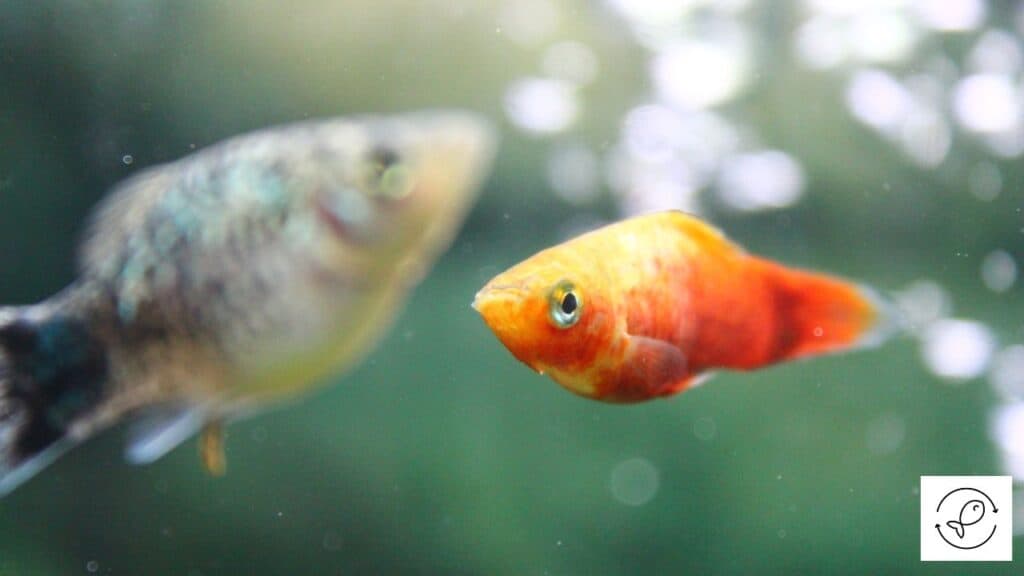All platy fry look similar. It’s difficult to identify their gender until they grow up.
So, how can you identify whether your platy is a male or female?
Big Differences Between Male and Female Platies
There are many physical and behavioral changes that can help you identify the gender of your platy.
The only thing is that you can only identify their gender once they reach the age of reproduction.
Given below are the most prominent differences between male and female platies.
Anal Fin Shape
Male and female platies can be identified by their distinct anal fin, which is their reproductive organ.
The anal fin is situated behind the pelvic fin, close to the anus.
The anal fins of both male and female platies are fan-shaped. However, there is a difference in the shape of these fins.
Male platies have a shorter and slimmer anal fin that doesn’t open as wide as that of female platies.
Also, the anal fin of male platies is pointed and called a gonopodium. The sharpness is necessary for inseminating female platies.
However, male platies can sometimes have their anal fins tucked in, though it’s folded down and easily visible.
On the other hand, female platies have a spherical and wide anal fin.
Tail Fin Shape
The tail fin of male and female platies look similar since both are fan-shaped.
However, you can notice the difference on a closer inspection.
Male platies have a shorter and more compact tail fin that corresponds to their body size.
On the other hand, female platies have a larger and broader tail fin due to their longer and bigger body.
Gravid Spot
The gravid spot is the most noticeable difference between male and female platies.
This spot is located in the mid-body area of a female platy’s abdomen, near its cloaca.
The gravid spot darkens and becomes more distinguishable as the pregnancy advances.
The dark spots are the developing fry cluster.
Male platies don’t have a gravid spot.
So if you notice your platy with a swollen belly and a gravid spot, it’s definitely a female platy.
Coloration

Male and female platies have similar patterns on their bodies.
However, you can distinguish between male and female platies by observing their coloration.
Male platies are more colorful than females. Female platies tend to be dull in color.
Male platies display bright colors to entice females to mate.
Body Shape and Size
The body shape and size are other distinguishing features of male and female platies.
Male platies are characterized by slim, streamlined bodies with slightly pointier heads and concave foreheads.
Female platies, on the other hand, are rounder and bulkier than males.
This allows extra space in their bellies to store food and carry live fry since they are livebearers.
Apart from the body shape, you can also identify the gender of platies by their size.
Male platies are smaller and can only grow up to 1.5 inches in length at max.
On the contrary, female platies are larger in size and can reach up to 2 to 3 inches in length.
However, the size of a platies doesn’t necessarily determine their gender.
Some female platies can be underdeveloped. So if they are judged solely on size, they can be easily mistaken for males.
Behavior
Male platies are more aggressive than female platies.
They are also always on the lookout for potential mates and often display courtship behavior to attract females.
Males are most noticeably aggressive when females are around them during the breeding season.
On the other hand, female platies are docile. They are usually peaceful and only get aggressive during feeding and pregnancy.
Female platies also usually become irritable when they are about to give birth.
At What Age Can You Differentiate the Gender Between Male and Female Platies?
The gender of platies can be determined after they are 5 to 6 months old.
That’s when their reproductive organs develop and become more visible.
Determining the gender of platies that are younger than five months is challenging due to their lack of distinct physical traits.
Moreover, some male platies can have delayed maturity.
Due to this, their male-specific physical traits develop between 6 to 8 months of age.
Can Platies Change Gender?
There is a widespread misconception that platies can change gender. But there is no scientific evidence to support this.
Platies look like females when they are born.
Since they are slow to mature, their gender isn’t identifiable until they are 5 to 6 months old.
Hence, some people think that female platies have changed into males.
While the truth is that they were males at birth who were late bloomers and acquired their gender-specific characteristics in the later stages of their life.

